Research to Inform the Five Year Review of the Home Report
Conducted to inform the five-year review of the Home Report. This research followed on from, and was informed by, the Home Report public consultation launched on 5 December 2013. The research study was conducted by Ipsos MORI and Retties and Co. and examined how the Home Report has performed over the past 5 years.
5 Performance of The Home Report Against its Objectives
This section considers the extent to which the three objectives of the Home Report have been met. It then looks at the relevance of these objectives in the future and whether any new objectives should be set.
The Home Report has three objectives
- To address the problem of multiple surveys
- To improve information about property conditions to provide an incentive for repairs to be done
- To address the problems created by the practice of setting artificially low asking prices.
Objective 1: Reducing multiple surveys
5.1 The first objective of the Home Report is to reduce multiple buyers commissioning surveys for one property, and buyers having to commission surveys for every property in which they are interested.
5.2 It is clear that, as defined in the original objective, this has been achieved.
5.3 It was common for industry professionals, and to a lesser degree national stakeholders, to argue that this had already been addressed prior to the introduction of the Home Report by the use of 'subject to survey offers'. However, others suggested that 'subject to survey' offers were not universal and raised their own issues, particularly for sellers and their solicitor, as the offer was liable to change with the results of the survey.
5.4 However, there was consensus among industry professionals that although multiple surveys had stopped, many sellers and buyers were now having additional surveys (or valuations) completed.
5.5 In the buyers and sellers survey, an additional survey or valuation[11] was commissioned for 23% of buyers and 30% of sellers (Figure 5.1).
Figure 5.1 Proportion of buyers and sellers who had additional surveys or valuations
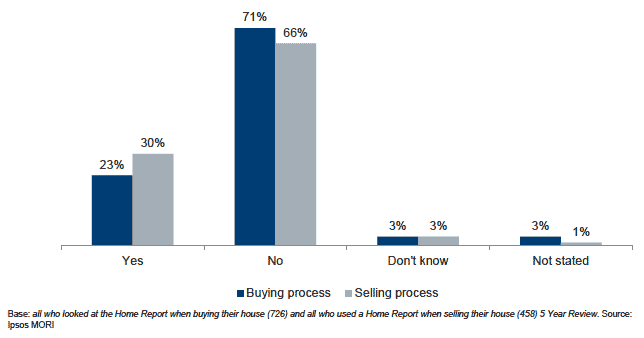
5.6 Among buyers who arranged an additional survey on the home they purchased:
- 58% reported that the type of additional survey was a mortgage valuation report;
- 56% reported that the reason for the additional survey was for mortgage lending purposes and, finally;
- 61% reported that the additional survey was advised by their mortgage provider.
These findings support the views of industry professionals who suggested that it was the lenders who were driving additional surveys.
5.7 Two-thirds of buyers paid for the additional survey themselves. Around half (48%) paid less than £300, while just over a third (33%) did not remember how much they paid.
5.8 It was more common for the additional survey to show a change in valuation rather than the stated condition (31% of buyers saw a change in valuation, compared with 16% who saw a change in condition) (Figure 5.2). The valuation was also much more likely to have dropped than increased (75% of values had decreased, 25% had increased).
Figure 5.2 Change in value and condition when additional survey/valuation carried out - buyers
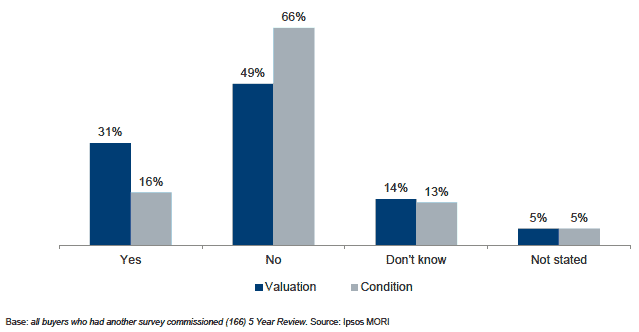
5.9 Sellers were much less likely to get an additional survey commissioned in the first 3 months that their property had been on the market than in the Interim Review (46% in the Interim Review, compared with 21% in this research). As 80% of those who commissioned an additional survey in this research did so because an offer was made on the property, this may be due to the fact that the time taken to sell a home has increased.
5.10 The majority of additional surveys commissioned were a refresh of the seller's Home Report using the same surveyor (73%). However, as with the buyers, they were most likely to say this was for mortgage lending purposes. It was most common for sellers to be advised by either the buyer (40%) or the buyer's estate agent (37%) that it was necessary to commission another survey, valuation or refresh.
5.11 As with buyers, most sellers who got an additional survey paid for it themselves (73%). Over half (54%) paid less than £200 for the additional survey and 30% did not remember how much it cost.
5.12 There was less change in either valuation or condition in the additional surveys that were commissioned by sellers compared to those where the buyer arranged them (Figure 5.3). Among those sellers that did see a change in valuation, the majority responded by lowering their selling price (60%).
Figure 5.3 Change in value and condition when additional survey/valuation carried out - sellers
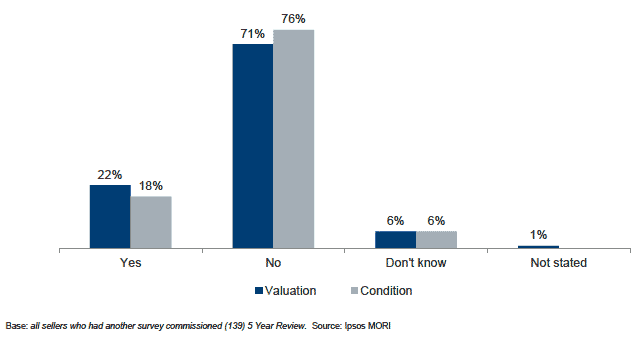
5.13 As the survey results highlighted, it appeared to be mortgage lender requirements that were most frequently driving additional surveys, a finding with which industry professionals were in agreement.
5.14 Lenders felt that the GMVR, which is not a compulsory part of the Home Report, was added to the Home Report at a late stage in the process of development and that the Home Report was not necessarily designed to meet mortgage lending purposes. They also had concerns around the conflict of interest - they are expected to lend a large amount of money to the buyer of a property, based on a valuation commissioned by the person trying to sell that property. Furthermore, they highlighted their need to limit risk when paying out large sums of money for borrowing purposes, particularly in light of the current economic climate.
5.15 These factors meant that they could be wary of using the mortgage valuation in the Home Report. However, they felt that they had found a way to work with the Home Report system by applying certain criteria (even if that meant that they sometimes requested additional surveys from buyers and sellers).
5.16 Each lender had slightly different criteria for requesting another mortgage valuation, which meant that there was no consistency in what was required from the buyers or sellers. However, there were a number of criteria that were most commonly used by lenders.
5.17 The first was the length of time that the property had been on the market. The Home Report is only a factual account of the property on the day of the survey and had no built in time limit. Lenders only tended to accept the Home Report valuation if it was less than 12 weeks old (although as this is not part of the legislation, it could vary by lender). If the surveyor who conducted the original Home Report was on the lender's approved panel (a list of surveyors that have been approved for use by the lender) the lender required a refresh of the Home Report. This was typically paid for by the seller.
5.18 Industry professionals and stakeholders felt that the 12-week cut off was arbitrary and, in a slow-moving market, too strict. While sellers were only advised to get an additional survey if an offer was made (and the Home Report was more than 12 weeks old) rather than every 12 weeks, it was thought to be unfair that they may be expected to pay for an additional survey that was of no direct benefit to them.
5.19 The second criterion was whether the surveyor completing the Home Report was on their approved panel. This was also the case in the previous system although the buyer commissioned those surveys so would be aware of surveyors they could use. In this instance, where the original surveyor was not on the lender's panel, the additional survey required by the lender would typically be an independent mortgage valuation paid for by the buyer. However, there were a small number of lenders who said that they paid for this.
5.20 The third was whether there was a discrepancy between the Home Report valuation and the accepted offer price. If a discrepancy existed and was more than a certain percentage (which varied between lenders) then the lenders would require an additional survey - again an independent mortgage valuation, usually by their own in-house surveyors. Again, this was usually paid for by the buyer, although some lenders said that they paid for this.
5.21 Selling agents felt that Home Report valuations on high value properties were routinely discarded by lenders in favour of an independent mortgage valuation, even if they met the above criteria. To some extent lenders agreed that properties with higher values were subject to more scrutiny, and therefore more likely to require an additional survey, due to the greater amount of money they were asked to provide. However, most said they did not have a price threshold above which every property required an independent valuation.
5.22 The majority of stakeholders and professionals thought that the issue of additional surveys, driven by mortgage lenders, needed to be addressed, as the criteria they were applying were too restrictive and gave the lenders too much power over the process. Some selling agents also believed that lenders did not always use the above criteria and arbitrarily asked for additional surveys.
5.23 It should be borne in mind that not all additional surveys were commissioned due to the lenders and may actually have been recommended by the Home Report. In the survey, a fifth of the additional surveys commissioned by buyers were in order to look at an aspect of the property in more detail such as the roof (if the surveyor could not get access) or to look at prospective repairs in more depth (e.g. by a damp specialist). Some professionals felt that it was very important for a buyer to commission an additional survey in these circumstances, and that buyers should not be discouraged from seeking out additional information where appropriate.
Objective 2: Improving property conditions
5.24 The second Home Report objective is to improve the condition of the housing stock.
5.25 It is difficult at this stage to conclude the extent to which this objective has been met.
5.26 Industry professionals held mixed views about the success of the Home Report in achieving this objective. However, all acknowledged that it is a long term objective.
5.27 Some stakeholders and, to a lesser extent housing industry professionals, felt that progress towards improving conditions was being made, albeit slowly. Those on the 'front-line' of the industry were less likely to think this was the case and many felt that the Home Report had made no difference to property conditions, and probably would not make a difference in the future. This was because they thought that sellers would only make small, cheap improvements, and that repairs would be used as a bargaining chip for the price rather than be completed.
5.28 The Scottish House Condition Survey (SHCS) provides data on the overall condition of the nation's housing stock. Figure 5.4 shows the proportion of homes in the owner-occupied sector in various forms of disrepair between 2007 and 2012, taken from the SHCS.
5.29 Overall, the proportion of homes in some disrepair has remained largely stable over the period, although there has been a significant decline in the proportion which are in 'extensive disrepair' (where at least 20% of a property is in need of repair). While this illustrates some progress in dealing with multiple disrepairs, we do not know what impact the Home Report has had as only a small proportion of these homes are likely to have been bought and sold over the period. Furthermore, the categories used to define repairs in the SHCS are different to those in the Home Report.
Figure 5.4 Percentage of properties in disrepair in Scotland in the owner occupied sector, 2007-12
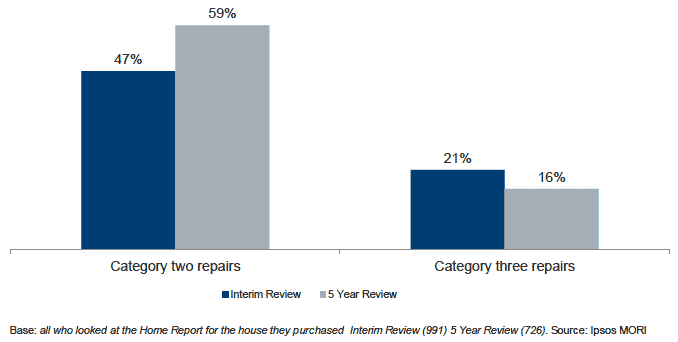
Source: Scottish House Condition Survey
5.30 Overall, sellers were less likely than buyers to report having repairs identified in the Home Report in the last home that they bought/sold. Just under half of sellers (47%) said that repairs (either category 2 or 3) had been identified in their property. However, nearly two-thirds of buyers said the same (65%).
5.31 Buyers were also more likely than sellers to make repairs that had been identified. Among buyers who had had a repair identified in the Home Report (either a category two or category three repair), 75% had made at least one of those repairs, the majority of those being category two repairs. This compares to only 36% of sellers who made at least one repair (again, either a category two or category three repair) identified before selling the property.
5.32 Buyers reported that the proportion of urgent (category 3) repairs identified had decreased since the Interim Review (21% in Interim, compared with 16% in Year 5). However, the proportion of category 2 repairs has increased (47%, compared with 59%) (Figure 5.5).
Figure 5.5 Change in repairs identified since Interim Review

5.33 Sellers were asked how much they had paid for the repairs that they had made. Half of those who made repairs spent £250 or less and only 10% spent over £1,000 on repairs (Figure 5.6). This suggests that sellers are most likely to make relatively minor and inexpensive repairs.
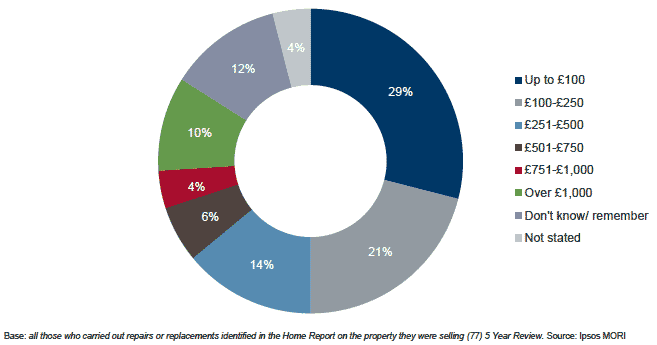
Objective 3: Preventing artificially low asking prices
5.34 The third Home Report objective is to prevent artificially low asking prices.
5.35 It is clear from the research that this has been achieved.
5.36 Since the Interim Review, there has been no change in the proportion of buyers who report that the property they last purchased was marketed as 'offers over'. Forty-four per cent of all buyers reported that the property they purchased was marketed as 'offers over' (Figure 5.7). However, this did not necessarily mean that the 'offers over' asking price was the same as the Home Report valuation.
Figure 5.7 - Property marketing strategies - buyers
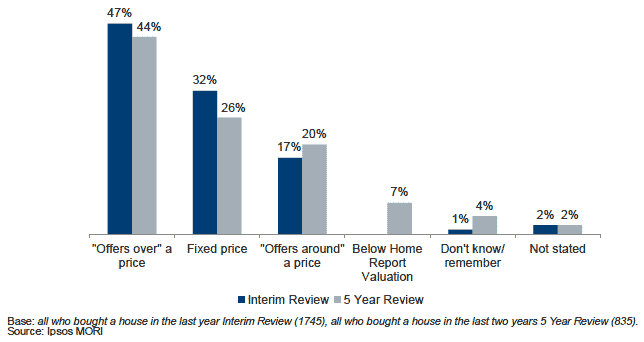
5.37 Among sellers, the proportion marketing the last property they sold as offers over had increased from 52% in the Interim Review to 60% now (Figure 5.8). There was also a corresponding fall in 'fixed price' marketing (31%, compared with 17% respectively).
Figure 5.8 - Property marketing strategies - sellers
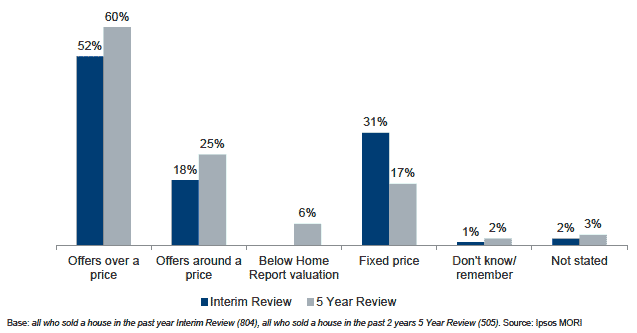
5.38 Professionals reported that when a property was marketed at 'offers over', the price stated was likely to be lower than the Home Report valuation, although, for the most part, not by a great deal. This was because they knew that the buyer could look at the Home Report valuation and see the price that the home was likely to sell at so there was nothing to be gained by marketing at an artificially low price.
5.39 In fact, some industry professionals knew of instances when the Home Report valuation was pushed upwards (by sellers or their agents pressurising surveyors) resulting in artificially high asking prices. This meant that the property could be advertised as 'below the Home Report valuation' but still achieve the price that they wanted.
5.40 In practice, while this objective refers to the marketed asking price rather than the valuation, of those buyers who had a Home Report, over half (54%) bought at under the valuation, compared to only 28% in the Interim Review (Figure 5.9). This is likely to be because of the poor market conditions in recent years and means that using artificially low asking prices would not be a successful marketing tool at this time. Some professionals questioned whether it was the market conditions rather than the Home Report that had reduced the prevalence of this practice and if it would return when the market picked up.
Figure 5.9 Differences between purchase price and valuation
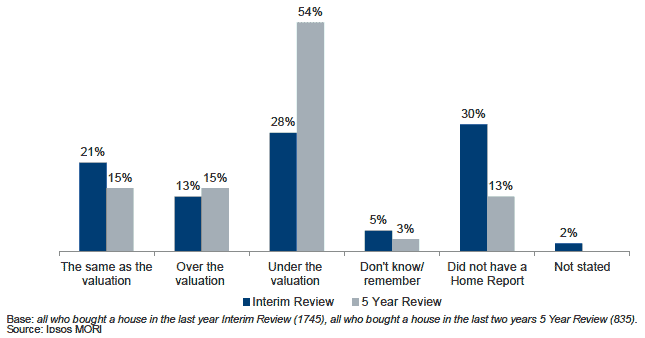
5.41 However, the valuation is one of the few things that the buyers look at in the Home Report with any consistency and had confidence in the price they paid because of it. Furthermore, half of buyers said they used the Home Report to help them decide on what to offer and over one-third used it in negotiations over price. This demonstrates that the Home Report valuation is helping to act as a price marker for buyers and could have a greater influence than the marketed price.
Views on continuation of the Home Report objectives
5.42 Professionals and stakeholders agreed that although the objective to reduce multiple surveys had been met in the strictest sense, the emergence of additional surveys meant that the problem had changed rather than been solved. For this reason, the consensus was that this objective should remain in place but be updated to take into account additional surveys as well as multiple surveys. As already highlighted, it will be important to clarify that additional surveys can be useful and buyers should be encouraged to access more information about the property they wish to purchase where appropriate.
5.43 While the objective of reducing artificially low asking prices was generally thought by professionals and stakeholders to have been met, there was a question raised over whether this would still be the case in different market conditions. One option would be to retain the objective as it is and see how the Home Report performs in a more buoyant market.
5.44 Professionals and stakeholders considered that improving the housing stock should be a long term goal that would only be met with slow progression. For the most part it was considered a relevant and appropriate objective that should be retained.
Possible new objectives
5.45 Neither industry professionals nor national stakeholders had many suggestions for future objectives for the Home Report
5.46 The one exception was the suggestion that, in order to improve the relevance and importance of the energy report, an objective should be set in relation to energy efficiency. It was suggested that this should either be linked to raising awareness of energy efficiency, or on raising the energy performance of households. Developing an objective around the energy report would require careful consideration and further thought should be given to how this would be built into the existing legislation surrounding the EPC.
Contact
Email: Ruth Whatling
There is a problem
Thanks for your feedback